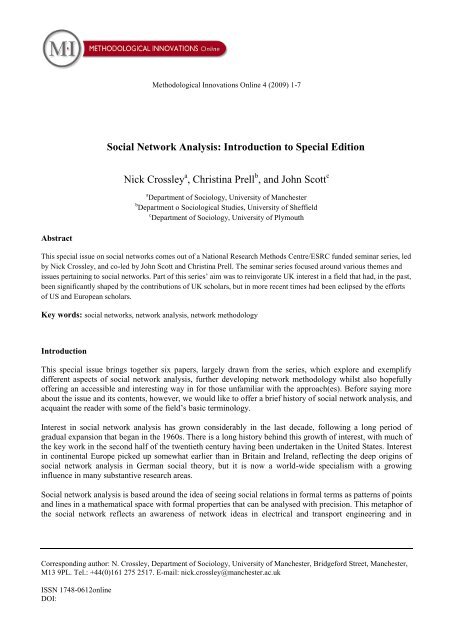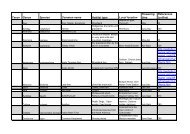Nick Crossley Christina Prell and John Scott
Social Network Analysis: Introduction to Special Edition ... - Plymouth
Social Network Analysis: Introduction to Special Edition ... - Plymouth
You also want an ePaper? Increase the reach of your titles
YUMPU automatically turns print PDFs into web optimized ePapers that Google loves.
Methodological Innovations Online 4 (2009) 1-7<br />
Social Network Analysis: Introduction to Special Edition<br />
<strong>Nick</strong> <strong>Crossley</strong> a , <strong>Christina</strong> <strong>Prell</strong> b , <strong>and</strong> <strong>John</strong> <strong>Scott</strong> c<br />
a Department of Sociology, University of Manchester<br />
b Department o Sociological Studies, University of Sheffield<br />
c Department of Sociology, University of Plymouth<br />
Abstract<br />
This special issue on social networks comes out of a National Research Methods Centre/ESRC funded seminar series, led<br />
by <strong>Nick</strong> <strong>Crossley</strong>, <strong>and</strong> co-led by <strong>John</strong> <strong>Scott</strong> <strong>and</strong> <strong>Christina</strong> <strong>Prell</strong>. The seminar series focused around various themes <strong>and</strong><br />
issues pertaining to social networks. Part of this series’ aim was to reinvigorate UK interest in a field that had, in the past,<br />
been significantly shaped by the contributions of UK scholars, but in more recent times had been eclipsed by the efforts<br />
of US <strong>and</strong> European scholars.<br />
Key words: social networks, network analysis, network methodology<br />
Introduction<br />
This special issue brings together six papers, largely drawn from the series, which explore <strong>and</strong> exemplify<br />
different aspects of social network analysis, further developing network methodology whilst also hopefully<br />
offering an accessible <strong>and</strong> interesting way in for those unfamiliar with the approach(es). Before saying more<br />
about the issue <strong>and</strong> its contents, however, we would like to offer a brief history of social network analysis, <strong>and</strong><br />
acquaint the reader with some of the field’s basic terminology.<br />
Interest in social network analysis has grown considerably in the last decade, following a long period of<br />
gradual expansion that began in the 1960s. There is a long history behind this growth of interest, with much of<br />
the key work in the second half of the twentieth century having been undertaken in the United States. Interest<br />
in continental Europe picked up somewhat earlier than in Britain <strong>and</strong> Irel<strong>and</strong>, reflecting the deep origins of<br />
social network analysis in German social theory, but it is now a world-wide specialism with a growing<br />
influence in many substantive research areas.<br />
Social network analysis is based around the idea of seeing social relations in formal terms as patterns of points<br />
<strong>and</strong> lines in a mathematical space with formal properties that can be analysed with precision. This metaphor of<br />
the social network reflects an awareness of network ideas in electrical <strong>and</strong> transport engineering <strong>and</strong> in<br />
Corresponding author: N. <strong>Crossley</strong>, Department of Sociology, University of Manchester, Bridgeford Street, Manchester,<br />
M13 9PL. Tel.: +44(0)161 275 2517. E-mail: nick.crossley@manchester.ac.uk<br />
ISSN 1748-0612online<br />
DOI:
<strong>Crossley</strong>, <strong>Prell</strong> <strong>and</strong> <strong>Scott</strong> / Methodological Innovations Online 4 (2009) 1-7 2<br />
geographical views of networks as l<strong>and</strong>scape features. However, the specific origins of the idea are firmly<br />
rooted in sociology itself (See the historical overviews in <strong>Scott</strong> 1999: Chapter 2; Freeman 2004).<br />
It was in classical German sociology that the idea of the social network was really established. In the various<br />
writings of Ferdin<strong>and</strong> Tönnies, Max Weber, <strong>and</strong>, above all, Georg Simmel there developed a sociological<br />
framework according to which large scale social structures had to be seen in terms of the social relations<br />
among individuals that resulted from their subjectively meaningful interactions. These theorists showed that<br />
interactions formed interweaving patterns of connection that comprise the warp <strong>and</strong> weft of social webs of<br />
connection. For many theorists, these webs of connection were to be analysed in formal terms, rather than in<br />
terms of their substantive contents. Social structures such as classes, states, <strong>and</strong> economies were envisaged as<br />
concatenations of these configurations.<br />
This work was combined with the insights of Gestalt psychology <strong>and</strong> field theory in the early ‘sociometry’ of<br />
Jacob Moreno (1934). Studying school classroom friendship choices, Moreno charted the connections as<br />
graphical patterns of points <strong>and</strong> lines <strong>and</strong> invented the term ‘sociogram’ to refer to these graphs. These<br />
insights were central to the group dynamics studies sponsored by the Michigan Research Centre <strong>and</strong> the<br />
Tavistock Institute in the 1940s <strong>and</strong> 1950s (Cartwright <strong>and</strong> Z<strong>and</strong>er 1953; <strong>and</strong> see Harary et al. 1965).<br />
The first actual use of the term social network, however, had been in anthropology, <strong>and</strong> it was here that many<br />
early advances were made. Alfred Radcliffe Brown saw the social structure as a network of relations, while<br />
his student <strong>and</strong> colleague Lloyd Warner explored network cliques in his community studies. Some of<br />
Warner’s ideas had been sharpened during his involvement in the famous Hawthorne studies, where the<br />
researchers had been struck by the similarities between the electrical wiring diagrams that littered the<br />
Hawthorne factory <strong>and</strong> the patterns of connection among the workers who produced this wiring.<br />
The psychological <strong>and</strong> anthropological works came together in the early 1950s when researchers at<br />
Manchester University <strong>and</strong> its Rhodes-Livingstone Institute — especially Clyde Mitchell <strong>and</strong> <strong>John</strong> Barnes —<br />
cooperated with the social psychological work on families being undertaken by Elizabeth Bott (1957) in her<br />
studies in London. These writers forwarded the use of formal mathematical ideas to study community <strong>and</strong><br />
family networks (Mitchell 1969).<br />
The mathematics that lay behind all the early uses of social network analysis was graph theory. This branch of<br />
mathematics developed as a way of representing any structure as a configuration of points (or vertices) <strong>and</strong><br />
lines (or edges). Theorems were constructed concerning the shapes or topologies produced by<br />
interconnections. Individual points could be described in terms of their local pattern of connections <strong>and</strong> their<br />
centrality in their networks, while whole networks could be described in terms of their overall density <strong>and</strong><br />
their division into cliques. These mathematical ideas found a ready application in sociological work.<br />
From the later 1960s, advances in computing began to make possible the investigation of large-scale social<br />
networks <strong>and</strong> an explosion in social network analysis took place. Initially at Harvard under the influence of<br />
Harrison White, researchers such as Mark Granovetter (1973) <strong>and</strong> Barry Wellman (1979) produced innovative<br />
work that influenced a generation of researchers. Influential early statements of the emerging position<br />
included Berkowitz (1982) <strong>and</strong> the edited collection by Berkowitz <strong>and</strong> Wellman (1983). Subsequent<br />
researchers added algebraic methods to the existing approach of graph theory <strong>and</strong> laid the basis for a much<br />
broader consideration of mathematical models. White (2008) has produced a powerful statement of the<br />
theoretical basis of this work. Later work has employed multidimensional scaling, statistical methods, <strong>and</strong><br />
agent-based modelling to advance the toolbox for social network analysis. Useful texts on these methods<br />
include Freeman et al. (1989), Wasserman <strong>and</strong> Faust (1994), <strong>and</strong> Carrington et al. (2005) <strong>and</strong> the edited<br />
collection of sources in <strong>Scott</strong> (2002).<br />
Whilst methodological <strong>and</strong> software developments have undoubtedly played a key role in stimulating the<br />
recent re-emergence of interest in network analysis, by making it both more sophisticated <strong>and</strong> more<br />
accessible, theoretical <strong>and</strong> substantive developments both within <strong>and</strong> outside of the social sciences have<br />
played a key role too. In particular, academic <strong>and</strong> policy debates on ‘social capital’, coupled with natural <strong>and</strong><br />
‘pop’ scientific interest in ‘small worlds’ (Barabási 2002, Watts 2004), have been important. This point merits<br />
brief elaboration.
<strong>Crossley</strong>, <strong>Prell</strong> <strong>and</strong> <strong>Scott</strong> / Methodological Innovations Online 4 (2009) 1-7 3<br />
Since the publication of Robert Putnam’s influential study of social capital there has been a growing interest<br />
in the application of social network ideas to this topic, <strong>and</strong> a corresponding influx of interest from social<br />
capital researchers. The ideas of ‘bridging’ <strong>and</strong> ‘bonding’ relationships have very clear social network<br />
implementations that have encouraged the development of analysis in this area (Burt 2007).<br />
Most recently, work in social network analysis has been influenced by physicists who have returned to earlier<br />
ideas on ‘small worlds’ pioneered by social psychologist Stanley Milgram <strong>and</strong> have proposed new directions<br />
for social network analysis (Barabási 2002; Watts 1999 <strong>and</strong> 2004). While much of this work was initially<br />
undertaken in ignorance of the earlier investigations in social network analysis <strong>and</strong> overstates the extent of its<br />
own originality <strong>and</strong> innovation, it has begun to reinforce a move amongst social network analysts to concern<br />
themselves with issues of structural change over time. The static orientation of much social network analysis<br />
has, in this work, been supplemented by more dynamic models.<br />
The papers in this special issue exemplify the influence of all these diverse str<strong>and</strong>s.<br />
<strong>Christina</strong> <strong>Prell</strong>’s paper, ‘Linking social capital to small-worlds: a look at local <strong>and</strong> network-level processes<br />
<strong>and</strong> structure,’ positions social capital as a sociological framework for explaining how small-worlds arise. In<br />
particular, <strong>Prell</strong> demonstrates how the processes by which actors invest in their ties <strong>and</strong> develop network<br />
strategies gives rise to a small-world network. In combining social capital <strong>and</strong> small-worlds, <strong>Prell</strong> shows these<br />
two perspectives gain from each other: small-worlds research lacks sociological depth, <strong>and</strong> social capital<br />
provides a rich account for how actors, networks, <strong>and</strong> resources interact with each other. In turn, by linking to<br />
small-worlds, social capital gains value as an explanatory theory in demonstrating how a social phenomenon<br />
outside the normal range of social capital discussion can be understood through a social capital lens. These<br />
propositions are then explored empirically through use of the p* model, one of the Exponential R<strong>and</strong>om<br />
Graph Modelling (ERGM) approaches developed by Wasserman, Pattison, <strong>and</strong> Robins (Wasserman <strong>and</strong><br />
Pattison 1996; Pattison <strong>and</strong> Wasserman 1999; Robins, Pattison <strong>and</strong> Wasserman 1999). Her article thus acts as<br />
a theoretical innovation <strong>and</strong> as an introduction to <strong>and</strong> illustration of the ERGM approach.<br />
<strong>Prell</strong>’s paper is followed by Deirdre Kirke’s paper on ‘Gender clustering in friendship networks: some<br />
sociological implications’. Deirdre Kirke investigates a friendship network of Dublin teenagers in order to<br />
examine the extent of homophily <strong>and</strong>, in particular, the gender clustering of friendship choices. Homophily, as<br />
she describes, refers to the preference of actors to form ties with others who are similar to themselves, <strong>and</strong> it is<br />
a well-documented occurrence within the SNA literature (Blau 1977). The data relate to a working class<br />
district of Dublin, first studied in 1987, <strong>and</strong> Kirke is able to use more recently developed approaches to social<br />
network analysis to re-examine these data. Her theoretical starting point is the idea that ‘social structures<br />
affect individual actions <strong>and</strong> that the individuals, in turn, form <strong>and</strong> change those structures when they form<br />
<strong>and</strong> change relationships’. Like <strong>Prell</strong>, Kirke makes use of an ERGM approach. Through this approach, she<br />
shows that initial friendship choices become the structural basis on which subsequent friendship choices <strong>and</strong><br />
interaction patterns are based <strong>and</strong> that the result is a growing division of the network around the initial genderbased<br />
choices. Thus, homophily has an influence on the flow of influence through the network, as it creates<br />
barriers to the free flow of influences. The effects of this are demonstrated in further data on substance misuse<br />
among the teenagers.<br />
Whereas <strong>Prell</strong> <strong>and</strong> Kirke both make use of more quantitative approaches to SNA, the next article in this issue<br />
seeks to integrate qualitative data alongside quantitative. In their article, Gemma Edwards <strong>and</strong> <strong>Nick</strong> <strong>Crossley</strong><br />
discuss how recent developments in social network analysis have been mainly quantitative in nature. In their<br />
paper, focusing upon the personal network (‘ego-net’) of a single militant suffragette, Edwards <strong>and</strong> <strong>Crossley</strong><br />
seek to bring some of these formal, mathematically based insights into dialogue with a more qualitative,<br />
content-focused <strong>and</strong> (in this case) archival approach. Each approach facilitates a deepening of the insights<br />
offered by the other, they demonstrate, <strong>and</strong> each begs questions for the other which drive analysis forward. As<br />
in social science more generally, we get the best out of both qualitative <strong>and</strong> quantitative approaches when we<br />
use them in combination. This paper also offers an introduction <strong>and</strong> contribution to one of the key substantive<br />
areas in which social network analysis has been developed: social movement studies.
<strong>Crossley</strong>, <strong>Prell</strong> <strong>and</strong> <strong>Scott</strong> / Methodological Innovations Online 4 (2009) 1-7 4<br />
Wouter de Nooy’s paper also focused upon application <strong>and</strong> also focused, if not upon qualitative methods then<br />
upon a theoretical tradition most often associated with it. In a fascinating <strong>and</strong> provocative analysis <strong>and</strong><br />
argument, de Nooy contends that the methods of social network analysis afford a rigorous way of<br />
operationalising key concepts <strong>and</strong> claims from within symbolic interactionism. Moreover, in what is<br />
essentially a self-critical <strong>and</strong> reflexive analysis, de Nooy retraces his own various attempts to offer a<br />
satisfactory analysis of network data pertaining to literary circles in the Netherl<strong>and</strong>s, outlining the successive<br />
stages that have led him to his own current position. As this path reflects, in important ways, that of social<br />
network analysis more generally across the period referred to, the paper also offers interesting insights into the<br />
way network thinking has evolved in recent years <strong>and</strong> the rationale behind much current thinking.<br />
Elisa Bellotti’s paper, like <strong>Christina</strong> <strong>Prell</strong>’s, seeks to bring together two important network concepts, in this<br />
case, Simmelian ties <strong>and</strong> brokerage roles. Like <strong>Prell</strong>, Bellotti focuses upon ‘social capital’. At a<br />
methodological level, the aim of the paper is to explore ways of identifying the different types of brokerage<br />
role (or position) that actors might occupy between relatively cohesive sub-groups within a network. A<br />
synthesis of methods, Bellotti shows, takes us further than either method can achieve in isolation. At a more<br />
practical level the paper, which analyses data pertaining to local social services dealing with youth substance<br />
abuse in Milan, on behalf of one such service, demonstrates how network analysis might serve the practical<br />
ends of those tasked to navigate one or more of the complex webs that comprise the domains of the social<br />
world. The paper suggests that sociometric maps, like the more conventional (geographical) maps we are all<br />
familiar with, might helps us in our capacity as everyday lay members of the social world to find our way<br />
around. By implication this perhaps also suggests a new cartographic role for social scientists.<br />
References<br />
Barabási, A. L. (2002) Linked: How Everything Is Connected to Everything Else. New York: Basic Books.<br />
Berkowitz, S. D. (1982) An Introduction to Structural Analysis. Toronto: Butterworths.<br />
Berkowitz, S. D. <strong>and</strong> Wellman, B. (eds.). (1983) Structural Sociology. Cambridge, Engl<strong>and</strong>: Cambridge<br />
University Press.<br />
Blau, P. M. (1977) Inequality <strong>and</strong> heterogeneity : a primitive theory of social structure. New York: Free<br />
Press.<br />
Bott, E. (1957) Family <strong>and</strong> Social Network. London: Tavistock.<br />
Burt, R. S. (2007) Brokerage <strong>and</strong> Closure: An Introduction to Social Capital. New York: Oxford University<br />
Press.<br />
Carrington, P. J., <strong>Scott</strong>, J., <strong>and</strong> Wasserman, S. (eds.) (2005) Models <strong>and</strong> Methods in Social Network Analysis.<br />
Cambridge: Cambridge University Press<br />
Cartwright, D. <strong>and</strong> Z<strong>and</strong>er, A. (eds.) (1953) Group Dynamics. London: Tavistock.<br />
Freeman, L. C. (2004) The Development of Social Network Analysis: A Study in the Sociology of Science.<br />
Vancouver: Empirical Press.<br />
Freeman, L. C., White, D. R., <strong>and</strong> Romney, A. K. (1989) Research Methods in Social Network Analysis.<br />
Fairfax: George Mason University Press.<br />
Granovetter, M. S. (1973) ‘The strength of weak ties’, American Journal of Sociology, 78, 1360-80.<br />
Harary, F., Norman, R. Z., <strong>and</strong> Cartwright, D. (1965) Structural Models. New York: <strong>John</strong> Wiley.<br />
Mitchell, J. C. (ed.) (1969) Social Networks in Urban Situations. Manchester: Manchester University Press.<br />
Moreno, J. (1934) Who Shall Survive? New York: Beacon Press.<br />
Pattison, P, & Wasserman, S. (1999) Logit models <strong>and</strong> logistic regressions for social networks, II.<br />
Multivariate relationships. British Journal of Mathematical <strong>and</strong> Statistical Psychology 52: 169-193.<br />
Putnam, R. D. (2000) Bowling Alone: The Collapse <strong>and</strong> Revival of American Community. New York: Simon<br />
<strong>and</strong> Schuster.<br />
Robins, G., Pattison, P., & Wasserman, S. (1999) ‘Logit models <strong>and</strong> logistic regressions for social networks,<br />
III. Valued relations’, Psychometrika 64: 371-394.<br />
<strong>Scott</strong>, J. (1999) Social Network Analysis: A H<strong>and</strong>book. Second Edition (originally 1991). London: Sage.<br />
<strong>Scott</strong>, J. (ed.) (2002) Social Networks. Critical Concepts in Sociology. Four Volumes. London: Routledge.
<strong>Crossley</strong>, <strong>Prell</strong> <strong>and</strong> <strong>Scott</strong> / Methodological Innovations Online 4 (2009) 1-7 5<br />
Wasserman, S. <strong>and</strong> Faust, K. (1994) Social Network Analysis: Methods <strong>and</strong> Applications. Cambridge:<br />
Cambridge University Press.<br />
Wasserman, S. <strong>and</strong> Pattison, P. (1996) ‘Logit models <strong>and</strong> logistic regressions for social networks, I. An<br />
introduction to Markov graphs <strong>and</strong> p*’, Psychometrika 61: 401-425<br />
Watts, D. J. (1999) Small Worlds. Princeton: Princeton University Press.<br />
Watts, D. J. (2004) Six Degrees. New York: W. W. Norton.<br />
Wellman, B. (1979) The Community Question: The Intimate Networks of East Yorkers. American Journal of<br />
Sociology. 84, 1201-31.<br />
White, H. C. (2008) Identity <strong>and</strong> Control. Second Edition (originally 1992). Princeton: Princeton University<br />
Press.













